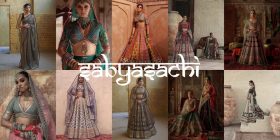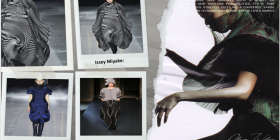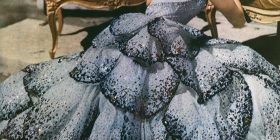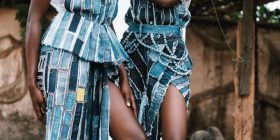Brands


Described as an ’International styling with an Indian soul’, Sabyasachi Mukherjee from Kolkata, India, is a luxury fashion designer who sells his merchandise using the world renowned label: Sabyasachi. Mukherjee had begun the building of his brand by borrowing his sister’s money – as his parents did not approve of his calling for fashion as it is culturally not considered a proper and well paid profession, making South Asian fashionmongers like myself relate to his story, and more determined to succeed in such a challenging industry. With his borrowed money, he opened up a store with a workforce of 3 employees and struggled to gain success for 5 years until he debuted at the Indian Fashion Week 2002, this brought him traction and caused his big break. Sabyasachi’s designs can now be seen in Bollywood and is sought after for bridal wear.
Being half Indian and growing up in the Western world, not seeing the appreciation and dealing with the discrimination of my culture, I was ashamed to parade my traditional clothes and jewellery. However, as Sabyasachi grew to fame and displayed the classical Indian style on diverse models, the culture was shared and open to everyone everywhere, and swiftly became adored by the public which sparked my pride in my culture. Through his promotion of the brand e.g. the elegant photoshoots flaunting his designs, the luxury designer made it the norm and trend to mix Western and Indian pieces in everyday wear.
To further praise his label, Mukherjee ensures his designs are based on the values of sustainability and ethical fashion, he hires over 3,000 traditional Indian artists to create his modern take on South Asian clothing. The variety of classical methods used in his textiles consist of; hand-dyeing, bandhani, gota patti (Indian embroidery) etc. Sabyasachi claims that ‘sustainability in fashion is not a luxury but a need for our future’ making him the pinnacle of Indian designers as – as unfortunate as it is – it is demanding to find ethical, luxurious and captivating fashion brands which follow the 4 main pillars required for a faultless brand.
In the fashion industry, people are an indispensable pillar. People represent consumers. Consumers’ choices and needs are related to society. We need to be fair and accepting of all consumers and promote a mutually beneficial relationship between people and society. Consumers in the Gen of Z are the main consumer groups in modern society. They have a unique aesthetic taste and have different views on things. At this time, the fashion industry should pay more attention to, tolerate and follow up the consumer groups in the Gen of Z.
Affected by the COVID-19 epidemic, Generation Z people will give priority to cost-effectiveness when purchasing goods and refuse financial losses caused by inflation, so they will give priority to practical items. Secondly, Generation Z is influenced by the metaverse and digital culture, and they will choose to use social media for shopping. And this type of group tolerates product diversity, and they are more inclined to choose diversified products. Moreover, environmental pollution has been serious in recent years. More Generation Z consumers are willing to choose environmentally friendly brands and boycott most brands that do not pay attention to environmental protection. (Mintel Company, 2023)
Barbie must be a symbol of Generation Z, and Mattel, the company behind Barbie, has made perfect use of brand diversity to attract Generation Z groups. Barbie is not only a toy, but also the epitome of children for many consumers. You can see different groups of people in different Barbies, regardless of skin color, age, or occupation. It represents power and tells children that you can be who you want to be. The person you want to be. Mattel has launched targeted Barbie dolls for children with Down syndrome and people with disabilities, which further demonstrates the brand’s diversity and social inclusion capabilities, allowing consumers to see themselves in the brand.
If a brand wants to develop in the long term and achieve the ideal standard of success, it requires a lot of interpersonal skills and an intertwined network of people to help achieve it. This requires staff to maintain agile thinking, and problem-solving skills, and use critical thinking to handle more important relationships. It requires companies and employees to have strong collaboration skills and tolerance, and communication is an important part of maintaining good interpersonal relationships.(Jefreda R.Brown,2022)

Balmain
Pierre Balmain (1914-1982) from a small alpine village in the Savoie region of France, is associated with the elite group of visionary designers that advised French fashion to its renaissance after World War two. Having briefly studied architecture Balmain chose to begin a career in fashion as an assistant to master couturier Lucien Lelong, working alongside Cristian Dior and Hubert de Givenchy in the autumn of 1945 Balmain left Lelong to establish his own fashion house.
After Balmain s death in 1982, the house has been managed by an array of designers, who have upheld the respect of the foundations and modern balance of the house. These designers consist of Erik Mortensen, Herve Pierre, Oscar de la Renta, Laurent Mercier, and Christophe Decarnin.
Balmain s profile has increased exponentially over the years since Rousteing became the creative director for the brand. Rousting being the first designer to reach a million followers on Instagram, Rousteing’s youth and famous fans, who he names “Balmain Army, teamed with an H&M collaboration in 2015 that brought global awareness, have associated with a newfound interest in the Parisian fashion house.
Balmain s unique selling point is that the brand ambassadors known as the “Balmain Army is ethnically diverse, showing consumers that the brand is ethical and encouraging them to support the brand. Rousteing believes that the rest of the industry is missing out if it fails to follow suit.
This distinct style of Balmain which usually includes gold medallions, buttons, and symbols, the brand’s unique liaison, ornament, and tassel creates his french house’s point of differentiation among its direct competitors.
The closer you look at Olivier Rousteing’s works, the more shocked you are by his superb craftsmanship. The craftsmanship of Balmain’s craftsmen lies in innumerable small details: the exquisite woven leather, the delicate embroidery, the intricate interweaving, the skillful pleating, the stunning corsets, and the delicate stitching. As a historic Parisian fashion house, Balmain continues its amazing craftsmanship while always maintaining a modern style, creating contemporary clothes for both men and women.

Issey Miyake
Issey Miyake was a Japanese fashion designer who combined Eastern and Western elements in his work. He achieved this by embracing innovation and technology to create unique and inspiring pieces. This has established Issey Miyake as an iconic figure in the fashion industry. Issey Miyake’s signature pleating techniques make his work distinctive. He drew inspiration from the togas of ancient Greece and the Fortuny gowns of 19th-century Venice for his designs. Miyake used polyester and heat-pressed the fabric to create these unique pleats, demonstrating modern fashion. Miyake constantly experimented with fabrics and shapes to create pieces that can be worn by individuals regardless of their age, gender, or body shape. The brand offers a simple and natural selection of clothing, making it popular. In addition to clothes, Issey Miyake also created perfumes, with “L’Eau d’Issey” being one of his best-known creations.
Issey Miyake showcased his work at Paris Fashion Week in 1974, a pivotal moment in his career that helped him gain global recognition. The 1995 spring runway collection illustrates how he experimented with machines to create his popular pleats as well as lightweight fabrics. During the 1995 spring shows, Miyake layered garment pieces that fell gracefully around the body. He displayed structured coats and experimental dresses. Issey Miyake remains a well-known brand that continues to grow and gain recognition. Moreover, Issey Miyake is still featured at fashion weeks around the world.

Ralph Lauren
Ralph Lauren, a distinguished name in the world of fashion, renowned for its designs and commitment to environmental responsibility. Founded by Ralph Lauren in 1967, the brand epitomizes timeless elegance and sophistication. Distinguished for its iconic polo shirts, tailored silhouettes, and commitment to quality, Ralph Lauren stands as a symbol of enduring luxury and refined taste in the fashion industry.
From organic cotton to recycled fabrics, Ralph Lauren is dedicated to reducing its ecological footprint without compromising on style. The brand also prioritizes transparency in its supply chain, providing consumers with insight into the ethical considerations behind each garment. By implementing various procedures across its operations to minimise waste and energy consumption, Ralph Lauren exemplifies a commitment to sustainable practices which resonate with their consumer values, making it a distinguished choice for those who seek both sophistication and environmental stewardship in their fashion choices.

Sandy Liang is a New York based fashion brand characterised for her feminine approach and use of childhood nostalgia in her designs. She inspiration from groups of women, childhood, nature and nostalgia, all in taffeta, pointe shoes and ribbons, Liang has created an instantly recognisable, cult followed brand. Recently she has gained new popularity through her collaborations with activewear brand Solomon and accessories company Baggu. These collaborations have taken the brand in a more graphic direction, while still maintaining the girlish charm that has become synonymous with Liang’s name. In the Solomon collab she took the traditional hiking shoe and reimagined it in a baby pink which gave an even more youthful and playful approach than before. On the other hand, while working with Baggu, she took influence from her Asian heritage and redesigned the traditional laundry bag print that her and so many others associated with their childhood and made it into a floral and youthful print. Both these collabs put Liang at a more accessible price point, with Baggu in particular offering much lower than usual prices and hence selling out almost immediately.
Nensi Dojaka


Nensi Dojaka stands out to me because of its modern cutouts and sexy sheer textiles which gives a different type of dimension for example to the essential “little black dress”. The brand focuses on customers which are in their 20s and 30s, though the designer has said in an interview in the Business of Fashion Magazine that she would like to “commercialise her aesthetic for a broader audience”. This shift seems quite tricky but it would be interesting to (maybe) see older powerful women (and men?) putting forward their control through the use of a well thought out semi bare skin outfit. Nensi Dojaka, however well known this fairly new brand is, it’s still struggling to see ends meet as it wasn’t able to hold its show at the latest London Fashion Week. It is invigorating to unfortunately grasp a bit of normalcy from such a brand in an industry who seems to never have limits.

Dior’s house has always exuded femininity, spanning from 1947 to present day. The idea was to present women as art, the silhouette of their clothes balanced with glamour.This fashion house holds up to the title of favourite brand due their consistency in their idea and the innovation of the brand.
When Dior first started, they up held their french house and only created one-of-a-kind pieces for exclusive customers. His designs were chic, womanly and exquisite; this still carries throughout the brand. However due to the innovation, the fashion house expanded into different areas of the world, different products which lead to different customers.
Dior managed to invite new people to enjoy new products, such as makeup, jewellery and ultimately beautiful clothes. Those who don’t want one piece, can find something more fitting for themselves. Though with new items, we treasure most the unique designs that started the brand; to famous pieces such as “Junon”, a magnificent skirt of ombréed petals, almost like peacock feathers, to “Bar”, honourably the most popular design in history, with a body-inch waist and padded hip design.
With a change of creative directors overtime, Dior has always been in the mouth of most, With one of the most talked about creative directors in history, John galliano. Those in fashion and those not in fashion know of john galliano, his designs and the feelings created when his clothes were pictured in magazines of ‘awe’ and bejewelled. With a proper foundation, the creative innovation succeed and allowed Diors fashion house to flourish not only in the past and present, but will continue into the future. As so, a personal favourite brand is Dior, The designs almost bring tears, and their lipstick always brings glossy lips.

NKWO
In 2007 Nkwo Onwuka burst onto the scene with her first ever collection that debuted at the V&A museum. It captured the eyes of many and led to her award win for best designer after several long years of experimenting with techniques and delving deeper into her Nigerian roots.
In 2012, Nkwo Onwuka continued to exceed our expectations and founded her own brand, NKWO. The artisanal brand puts natural resources at the forefront of every intricate detail and innovative design as part of Nigeria’s sustainable fashion movement. As a brand, their primary goal is to reduce textile waste, and they achieve that by upcycling materials such as denim and cotton.
NKWO uses the concept of restoration and reduction to highlight tradition value systems that have been corrupted by fast fashion. And as the rate of pollution continues to rise at an alarming rate, consumers are drawn to NKWO’s collections as each garment expresses a strong commitment to the preservation of our environment and conveys a vivid story.
The brand fuses traditional techniques like beading, embroidery, dying and weaving with modernised designs and works directly with artisans and local makers to bring significant change.